Amaranth Flower Arrangements
Amaranth Flower Arrangement Ideas
Try These Amaranth Floral Arrangements for Yourself
If you follow floral trends, you’re sure to have seen amaranth make an appearance.
While amaranth flower arrangements are no doubt having a moment, humankind has been using this flowering plant for millennia and it’s one of the world’s oldest cultivated crops.
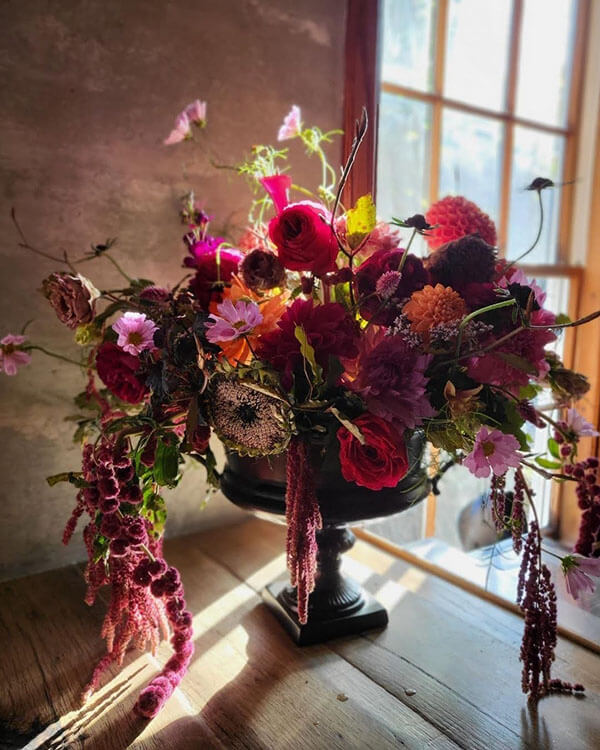
What is new, though, is the creative ways that florists, event designers, and interiors experts are using the amaranth plant to add drama and depth to everything from bridal bouquets to al fresco tablescapes.

But what is amaranth exactly and why is it so popular right now? Keep reading to find out more about this unique plant and how to use it in your own arrangements.

Amaranth Flower Meaning and mystique
The amaranth plant — sometimes referred to by its scientific name, amaranthus — can grow up to three feet tall. Its hanging flowers come in several shades, including deep purple, dramatic red, delicate lavender, white, and yellow-green.
But amaranth’s beauty is beyond skin deep. And part of its enduring appeal lies in the plant’s meaning and the mystique behind it. The name “amaranth” comes from the Greek amarantinos, meaning unfading.
Often associated with immortality, everlasting love, and eternal life, the amaranth’s flowers and leaves don’t die when the seasons change. Ancient cultures also used amaranth to signify rebirth, viewing the way it thrives in warm, sunny climes to be a representation of light, love, and life itself.
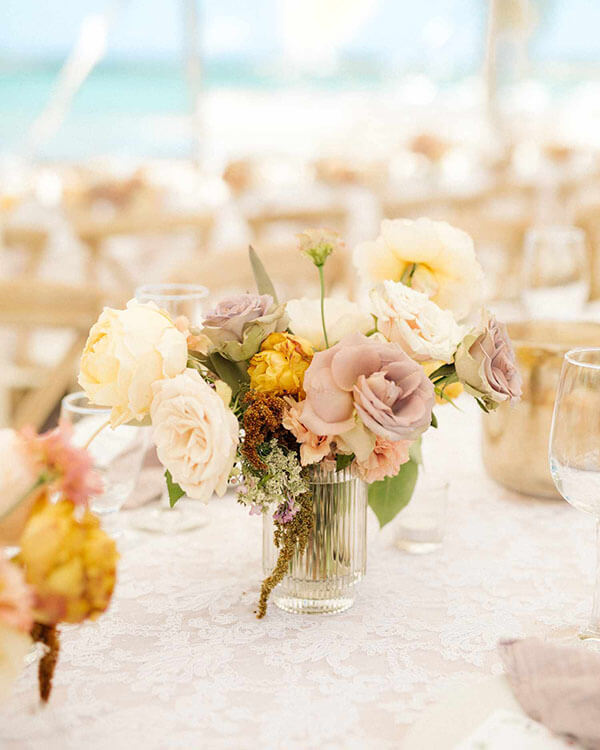
Amaranth flower arrangement ideas
Creating floral arrangements that live up to the significance behind amaranth might feel daunting, but amaranth is far more versatile than many people realize, as these ideas show.
Classic drama
Amaranth flowers add texture and depth, creating an air of quiet drama with velvety hanging fronds that are both show-stopping and humble all at once.
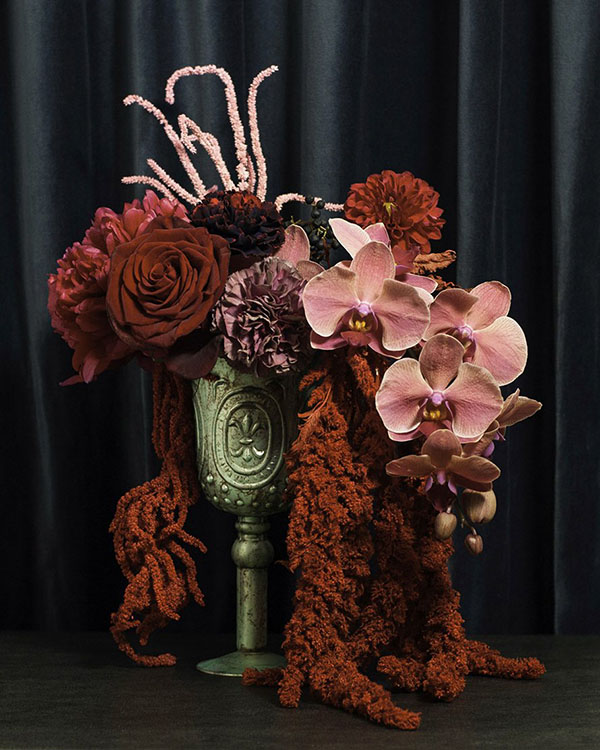
And there’s no better way to highlight this than with deep red amaranth tumbling over the aged metallic tones of a pedestal bowl. The combination of reds and pinks invites yet more drama, while the textural delights of burgundy roses and silk orchids top everything off to perfection. It’s a gorgeous bouquet for Valentine’s Day too.
NEUTRALs
If you’re on the hunt for a sophisticated arrangement with a neutral palette, amaranth is a must. Especially if you can find some in this very autumnal shade of brown.
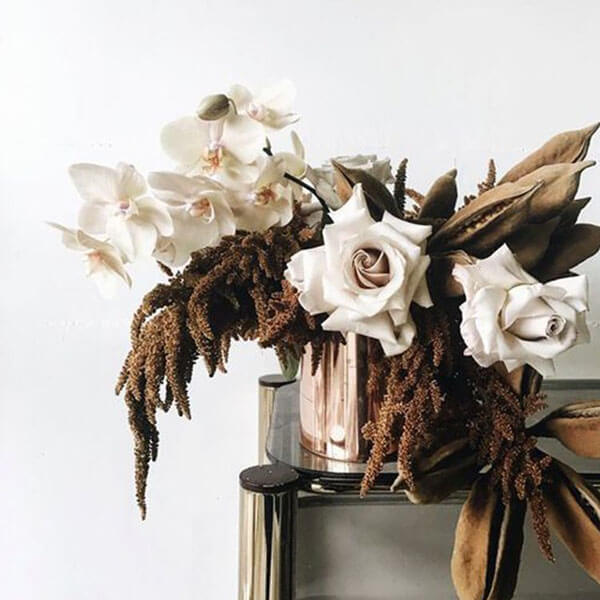
Here the arrangement plays on the downward drape of the brown amaranth, allowing the tinted white roses to fall into place above it. The sculptural dried pods offset the sleek polished brass vase for a bold yet balanced look that’s also ideal for capturing the nostalgic yearning that fall brings.
Structural styling
The versatility of amaranth means that it pairs just as well with structural and spiky succulents as it does with delicate flowers.

This arrangement combines a variety of colors and textures to create a look that feels fun but grounded. The fuchsia amaranth shifts the focus away from the central succulent plant, offering a burst of color, softness, and plenty of character.
That said, different-shaped leaves in various shades of green and the simple zinc bucket container play down these contrasts well. This allows the amaranth to shine without the arrangement feeling forced.
You might even consider this kind of alternative arrangement for a festive holiday tablescape. All you’d need to do is combine red and gold amaranth with green leaves and succulents for a subtle nod to the classic Christmas color palette.
Delicate dahlias
Amaranth has a reputation for being bold. But when it’s used sparingly, it can be subtle enough to add the perfect finishing touch to delicate arrangements.

The tiny trails of amaranth in this table arrangement offer just a hint of their full potential for creating depth and texture. But this is more than enough to draw your eye away from the red dahlia stem in the center. With the white flowers and porcelain urn vase tying everything together nicely, the result is luxurious but unpretentious.
Trailing greenery
Since amaranth also comes in green, it’s useful as a kind of floral foliage, adding softness and texture beyond the scope of regular leaves.
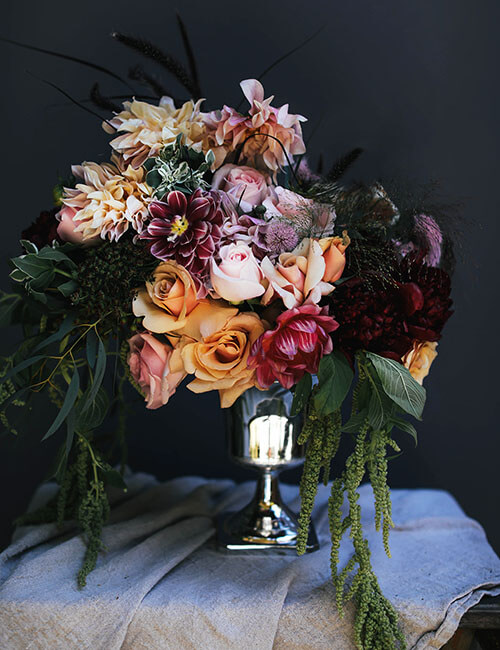
The trailing green amaranth in this arrangement balances out the top-heavy drama created by the roses and dahlias spilling from a metallic urn in various shades of burgundy, peach, and pink. The final look is one of undone glamour, evoking effortless beauty and style.
Cascading AMARANTH bridal bouquet
Amaranths might not be one of the most popular wedding flowers (yet!) but their symbolism of eternity and unfading love make them a fitting addition to a bridal bouquet. In some parts of the world, couples have even started to exchange amaranth flowers as a sign of everlasting love.

As this wedding bouquet shows, the way the amaranth cascades in front of the bride’s dress, also adds an eye-catching effect. This quality makes amaranth ideal for those wanting something a little different from the usual peonies and sweet peas. Although, the romantic cream and pink preserved roses and soft greenery details in this particular bouquet ensure that the finished look is still classic.
Try these amaranth floral arrangements for yourself
From bold and colorful bouquets to delicate floral displays, it’s clear that amaranth is as versatile as it is striking.
And with these looks to guide you, you should now have plenty of ideas about how to arrange amaranth in a way that highlights its eternal appeal and unique beauty.
Looking for the perfect way to add life to your home or an upcoming event? Be sure to check out the full Jamali Garden range of silk flowers and plants for more inspiring options.

